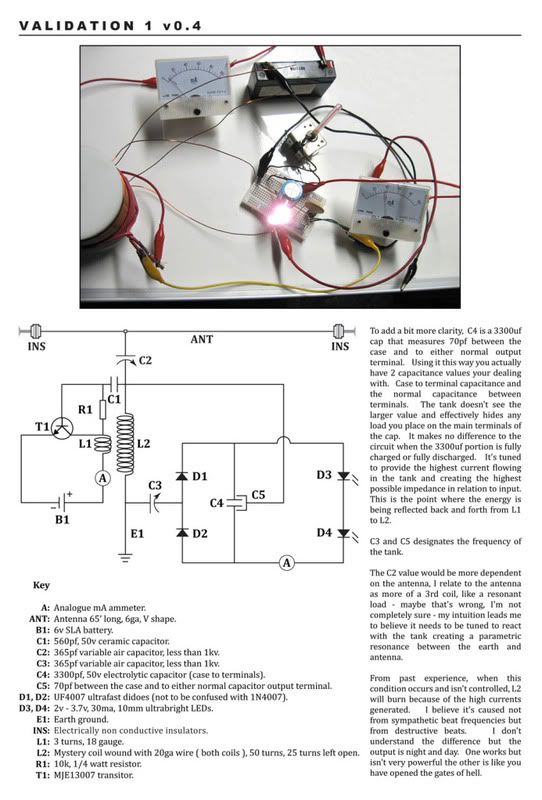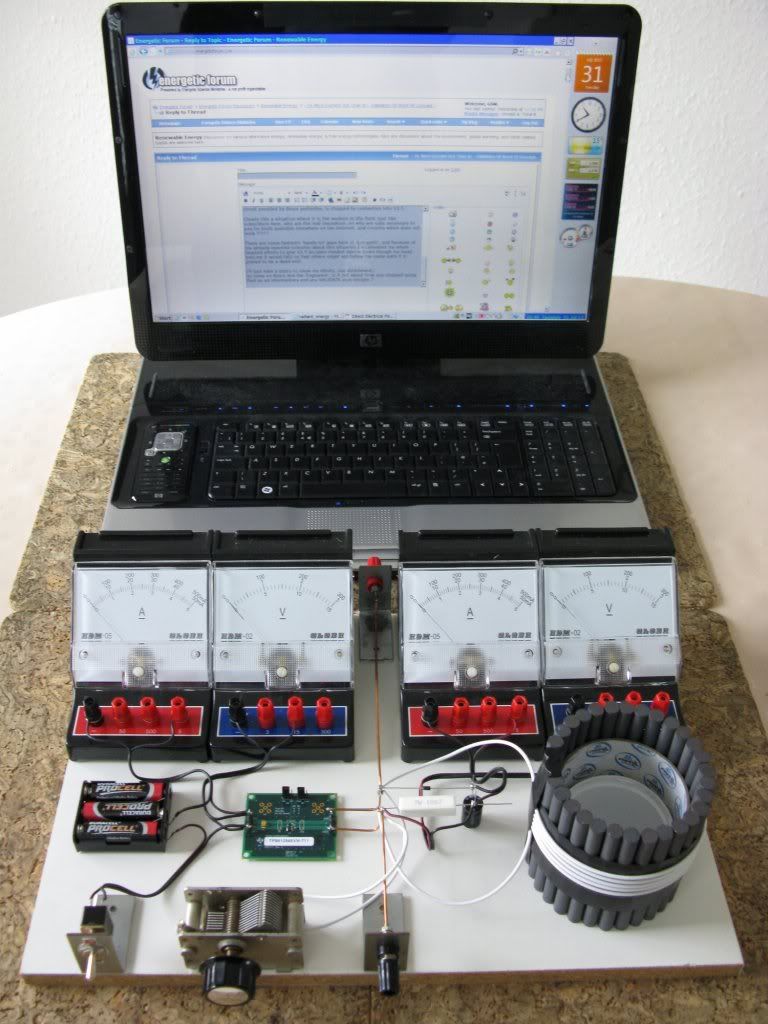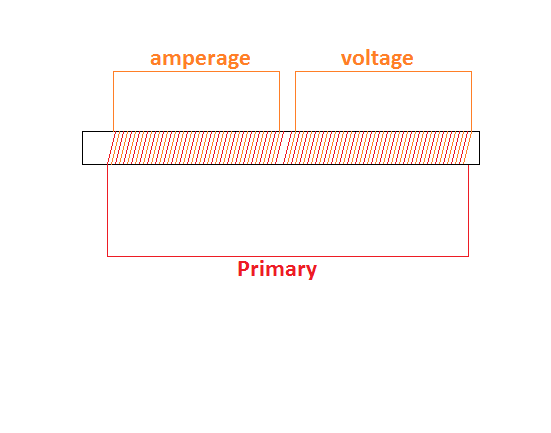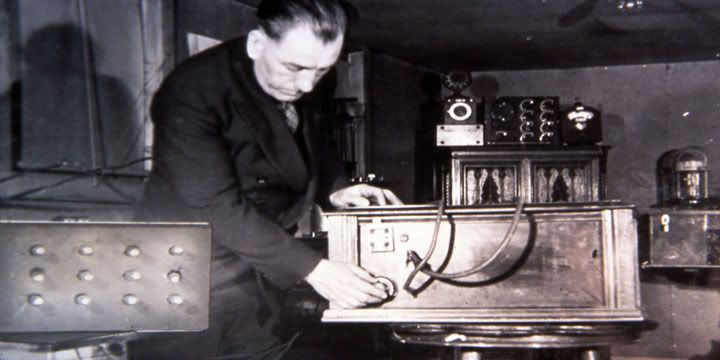Hi Paul,
I don't know where I downloaded V2.5 from, but it was the Texas IC version.
Had I downloaded the single transistor BFO version presently published I would not even have attempted replication because it won't work.
I was under the impression that the TI chip was used because it switched at 3.5MHz, but I had no way of knowing in advance whether it would actually drive the circuit, which of course it won't.
Great to see your basic proposals - excellent.
What you have stated is no more than a professional magazine editor would require anyway !
Though of course there would be great need to NOT publish imagery of live OU lest the doors start getting knocked. Only parts of the circuit at a time in one shot.
You wrote -
"I feel quite honored that this was the first device you have ever had enough faith in to give a it a go."
Yet I had reason, and this being that the TI chip is a mosfet conduction *pull up* regulator;
unlike the crystal oscillator which is a bipolar conduction *pull down*.
The chip won't work because the output pulse is not at 3.5MHz, only the sensing.
The bipolar BFO won't work because the only pull up is via a 1,000 ohm resistor.
What is needed is a *pull up* BFO where the output device pulls the antenna/coil voltage upwards towards the supply potential - a mirror image of the last suggested crystal oscillator circuit.
If bipolar the BFO should be a two transistor PNP darlington configuration, with say 22 ohms between the base and the emitter of the output device to ensure fast switch off; the output device being a fast small power transistor as used in video stages, only the PNP complementary version.
(At these frequencies avoiding device saturation and lazy switch off becomes most important.)
Yes an Armstrong oscillator will work, though again could not be as frequency stable with temperature and supply voltage variations. Another disadvantage here would relate to beats, for the field from the main V2.5 coil would unavoidably pull the tuning of an Armstrong oscillator, thus rendering the tuning of a beat impossible.
(I often wondered not only whether the Hendershott twin coils were beating, but how immense their RF alternating magnetic field must have been.)
I really don't know whether I have any crystals circa 3.5MHz, so will need another expedition into the roofspace in case there might be one in a spare radio chassis.
If you wish to run any circuits past me I should be pleased to do so in full confidence, for I have great respect for the circuit ownership of others, and as anyone will tell you who knows me in real life - I don't do anything for money, and I give all my own ideas away freely too.
You also wrote -
"If it works with LEDs self looping or not it still wouldn't satisfy you because of the possibility of a military transmitter."
But why should my satisfaction even this come down to a situation where I am expected to believe anything. A SW radio is all that is necessary. Tune in to the device, then turn the device off and tune nearby frequencies to show that there is nothing there.
If you sharpen your pencil, and I warm up the soldering iron, maybe the rest of the ION team can get their heads together to sort out exactly what it is our circuits should be doing, so that everyone can move forwards sooner rather than later.
Cheers ........ Graham.
PS. Of course I could e-mail privately, but this project needs as many minds as possible, and in as many countries as possible.
I don't know where I downloaded V2.5 from, but it was the Texas IC version.
Had I downloaded the single transistor BFO version presently published I would not even have attempted replication because it won't work.
I was under the impression that the TI chip was used because it switched at 3.5MHz, but I had no way of knowing in advance whether it would actually drive the circuit, which of course it won't.
Great to see your basic proposals - excellent.
What you have stated is no more than a professional magazine editor would require anyway !
Though of course there would be great need to NOT publish imagery of live OU lest the doors start getting knocked. Only parts of the circuit at a time in one shot.
You wrote -
"I feel quite honored that this was the first device you have ever had enough faith in to give a it a go."
Yet I had reason, and this being that the TI chip is a mosfet conduction *pull up* regulator;
unlike the crystal oscillator which is a bipolar conduction *pull down*.
The chip won't work because the output pulse is not at 3.5MHz, only the sensing.
The bipolar BFO won't work because the only pull up is via a 1,000 ohm resistor.
What is needed is a *pull up* BFO where the output device pulls the antenna/coil voltage upwards towards the supply potential - a mirror image of the last suggested crystal oscillator circuit.
If bipolar the BFO should be a two transistor PNP darlington configuration, with say 22 ohms between the base and the emitter of the output device to ensure fast switch off; the output device being a fast small power transistor as used in video stages, only the PNP complementary version.
(At these frequencies avoiding device saturation and lazy switch off becomes most important.)
Yes an Armstrong oscillator will work, though again could not be as frequency stable with temperature and supply voltage variations. Another disadvantage here would relate to beats, for the field from the main V2.5 coil would unavoidably pull the tuning of an Armstrong oscillator, thus rendering the tuning of a beat impossible.
(I often wondered not only whether the Hendershott twin coils were beating, but how immense their RF alternating magnetic field must have been.)
I really don't know whether I have any crystals circa 3.5MHz, so will need another expedition into the roofspace in case there might be one in a spare radio chassis.
If you wish to run any circuits past me I should be pleased to do so in full confidence, for I have great respect for the circuit ownership of others, and as anyone will tell you who knows me in real life - I don't do anything for money, and I give all my own ideas away freely too.
You also wrote -
"If it works with LEDs self looping or not it still wouldn't satisfy you because of the possibility of a military transmitter."
But why should my satisfaction even this come down to a situation where I am expected to believe anything. A SW radio is all that is necessary. Tune in to the device, then turn the device off and tune nearby frequencies to show that there is nothing there.
If you sharpen your pencil, and I warm up the soldering iron, maybe the rest of the ION team can get their heads together to sort out exactly what it is our circuits should be doing, so that everyone can move forwards sooner rather than later.
Cheers ........ Graham.
PS. Of course I could e-mail privately, but this project needs as many minds as possible, and in as many countries as possible.





 Graham I value your input and after seeing your build, I'm looking forward to seeing what scope you have
Graham I value your input and after seeing your build, I'm looking forward to seeing what scope you have 





Comment